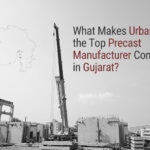In building, the true tale isn’t on the skyline, it’s on the skeleton.
Behind every hastily ascending tower or sprawling industrial complex lies a behind-the-scenes revolution altering the way India constructs: Precast beams.
They’re not only quicker versions of the old ways; they’re a new way of thinking about structure. And Urbanaac, Gujarat’s premier precast producer, is at the very forefront of it.
Let’s dive deeper, not into what they are, but why they’re important.
The Problem with the Old Way
Conventional RCC beams are cast in situ, which sounds easy, but actually, it’s a juggling act of variables:
- Weather, labor, curing, quality inspections, delays.
- Each day on-site introduces unpredictability.
- Each inconsistency in the concrete mix or alignment becomes a future crack in the system.
- Developers don’t merely lose time; they lose confidence.
- That’s where precast beams alter the equation.
- From Reactive to Predictive Construction.
- Precast isn’t about “speeding up” construction.
- It’s about re-engineering control.
At Urbanaac’s precast facility, beams are engineered through digital models, cast through automated batching, and cured under optimal conditions.
This moves construction from a reactive process (“we’ll fix it on-site”) to a predictive one (“we know exactly how it will perform”).
That’s a monumental shift in how projects are planned, budgeted, and executed.
Precision that Translates to Performance
Let’s get technical for a second. A structural frame works only as well as its connections.
Precast beams by Urbanaac come with factory-set tolerances as low as ±2 mm. That translates into when they connect to columns and slabs, load transfer is precise, deflection is minimized, and stress is distributed evenly.
In other words, the building breathes evenly, lives longer, and stands stronger.
Reimagining Architecture, Not Just Engineering
Think precast is all about function, no flair? Think again.
Urbanaac’s design flexibility enables architects to experiment with cantilevered spans, curved geometries, and open-floor designs, things just about impossible with on-site casting.
Form follows function, but in this case, freedom follows precision.
Sustainability Beyond Buzzwords
The true sustainability tale of precast beams isn’t so much about conserving cement, it’s about conserving cycles.
Less rework. Fewer transport trips. Briefer project timetables.
Each beam conserves hours, days, and diesel, which, when extrapolated across cities, is a meaningful environmental trend.
Urbanaac refers to this as “sustainability through efficiency”, a philosophy that permeates every product line.
- The New Measure: Structural ROI
Building contractors today don’t gauge success in terms of how fast or how high they construct; they measure success in terms of how little they need to go back and touch it.
Precast beams reduce lifecycle expenses by a lot: fewer cracks, less maintenance, and greater resale value thanks to structural integrity.
It’s not cost-cutting, it’s capital preservation.
- Constructed for India’s Next Decade of Growth
India’s urbanization requires scale, housing, metros, bridges, and factories, all rising at once. And precast beams are the sole means to achieve that pace without sacrificing integrity. With automation, design scalability, and in-house logistics, Urbanaac is constructing the backbone of rapid, future-proof infrastructure.
Final Thought: From Beam to Belief
The role of a beam is straightforward: to bear weight.
But Urbanaac’s precast beams bear more than that. They bear trust, of builders who can better plan, engineers who can sleep better at night, and cities that can build smarter.
In every sense of the phrase, precast beams aren’t merely a part of a structure,
they’re the structure of what’s next.








